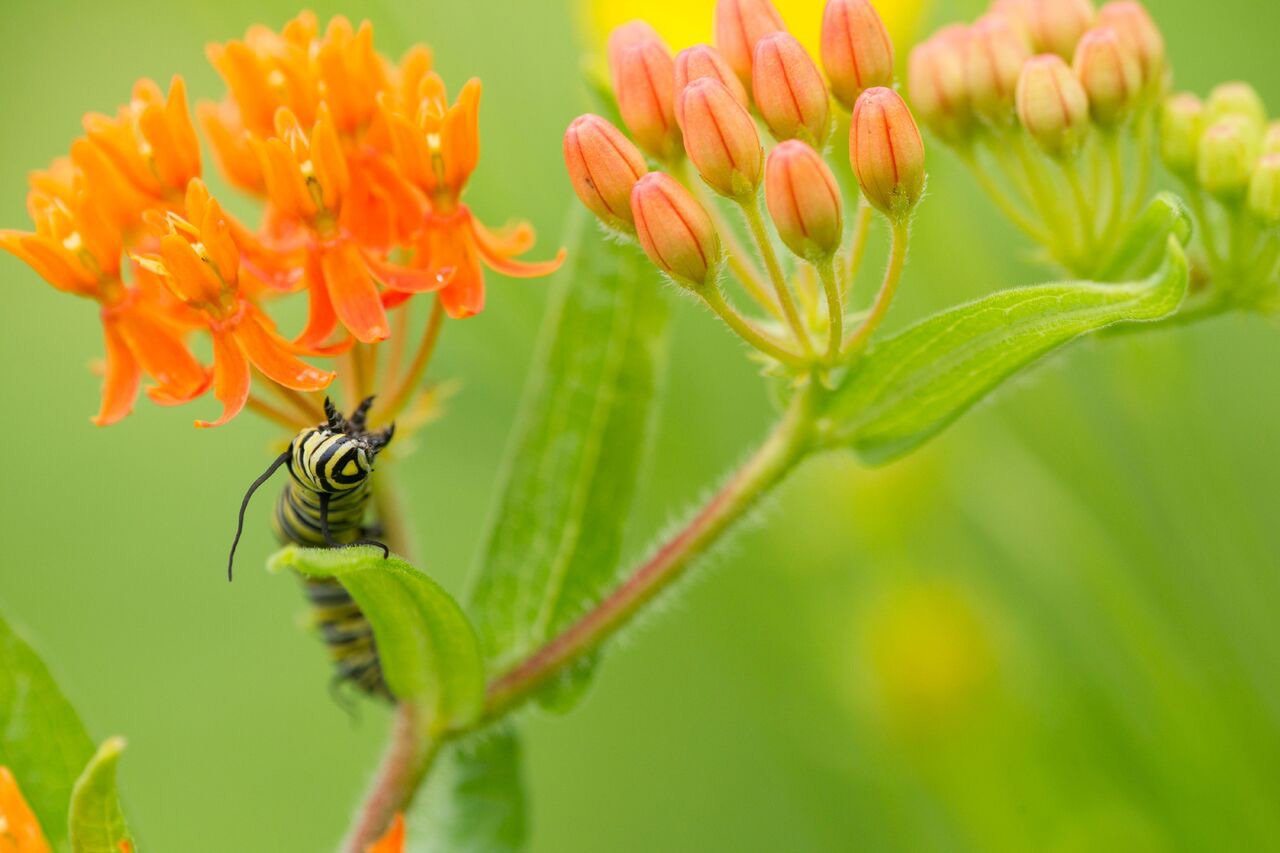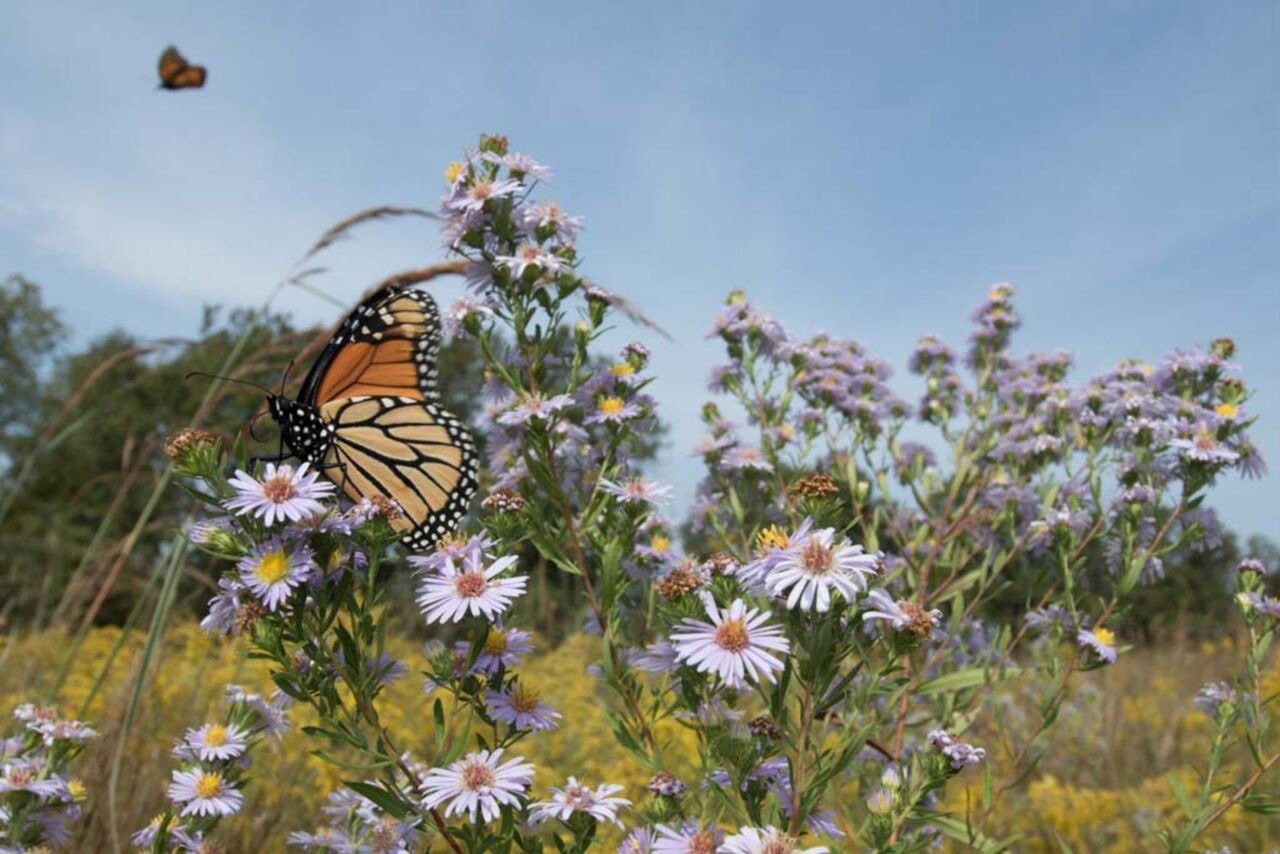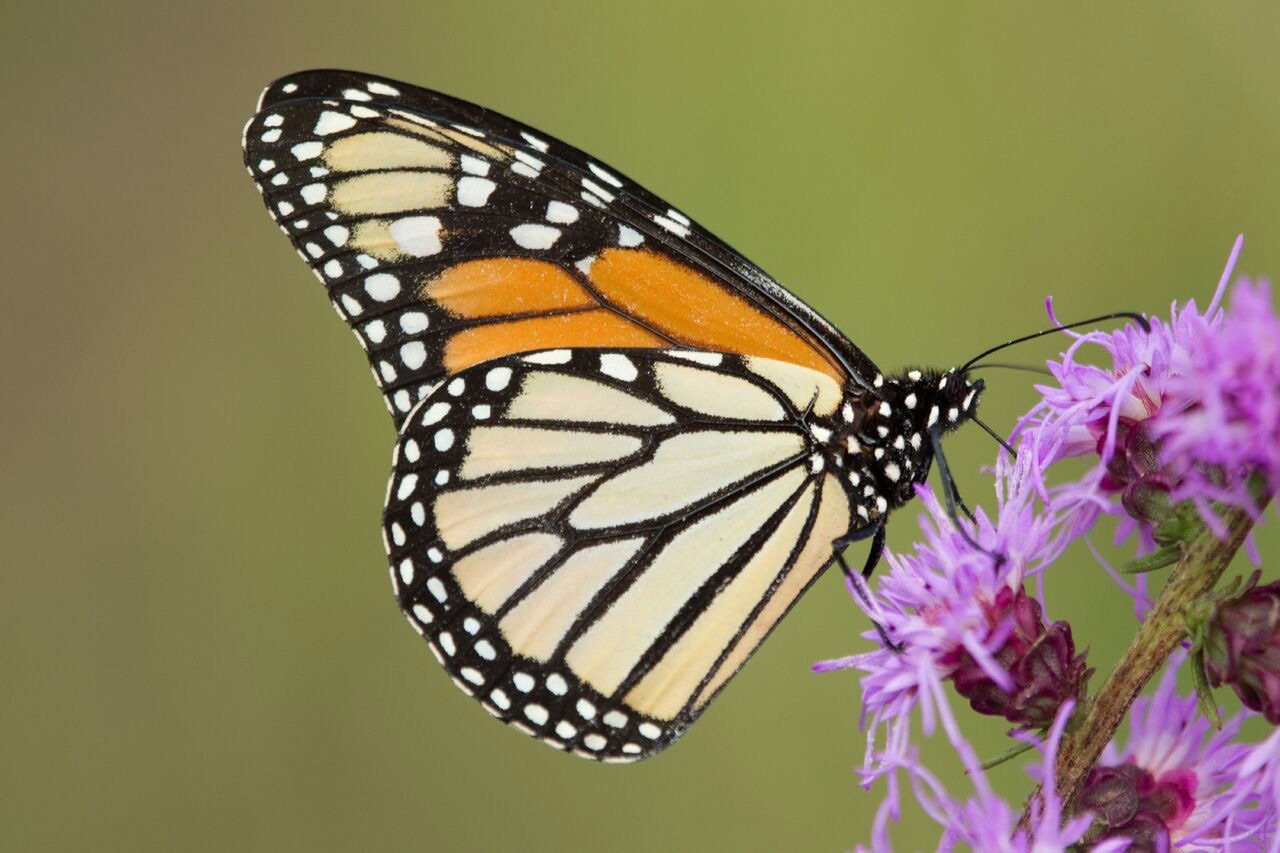Editor’s Note: This story was originally published in April of 2017. We have updated information in the story to reflect recent changes to Missourians for Monarchs.
The monarch butterflies outside your window are in the middle of a long journey. Missouri is a stopping point in the annual monarch butterfly migration from Canada to Mexico. In the fall, much of the traveling population will touch down along the four-hundred-mile-wide corridor along interstate 35 during the butterflies’ more than 2,000-mile journey to central Mexico. Their descendants will return to our state near the end of April, on their way back to Canada.
Monarchs are a truly phenomenal species, and their multigenerational migration still bewilders scientists. It’s hard to fathom. Somehow, over the course of several lifecycles and many months, the final generation of monarchs end each year’s migration in the same tiny area where their ancestors began, in a few-acre-wide area of the oyamel fir forests in central Mexico. Many of the butterflies that inhabit and breed on more than a billion acres across North America throughout the year will end up taking root in the same tree their great-great-grandparents did the year before.
Fewer and fewer monarchs are making the treks each year, raising alarm among the researchers and conservationists who track them. “The monarch butterfly in the past two decades has had a population collapse,” says Kelly Srigley-Werner, state coordinator for the Missouri Partners for Fish and Wildlife Program of the US Fish and Wildlife Service. “There were close to a billion monarch butterflies twenty years ago wintering on about forty-five acres (in Mexico). In the winter of 2013-2014, the population had declined to an estimated 33 million, occupying just 1.66 acres.”
Several factors have contributed to the monarch population decline. Illegal logging in Mexico has shrunk the monarch’s overwintering grounds. Some experts suspect climate change or recent droughts are contributing factors in habitat loss.
The search for solutions has become an international effort coordinated across North America. In the United States, butterfly counters point to increasing development and modern agricultural practices as factors of the reduced “trac” on what is known as the Monarch Highway, the loose path of migration along I-35. In the Midwest stretch of the Monarch Highway, butterflies are having a much harder time finding food and homes.
Missourians for Monarchs—a collaboration among more than forty governmental, agricultural, and conservationist groups—is working to make sure the butterflies can safely lay over in fields and gardens. They hope that, by preserving and creating more breeding and feeding grounds, populations will bolster during the annual migration.
In the fall migration, a single generation called the “Methuselah generation” flies from Canada to spend the winter in the tiny patch of forest in central Mexico. Named after the Old Testament figure of the same name who is said to have lived 969 years, these monarchs live much longer than their kin—for a full eight or nine months compared to four to six weeks. Still, they are several generations removed from any butterfly that traveled to Mexico a year ago.
After the winter months in the oyamel firs, monarchs will begin a journey back across North America. This trip progresses at a much slower rate, cycling through several generations. After leaving Mexico, a generation of monarchs will stop around Texas to mate, lay eggs, and soon die. After the eggs hatch and caterpillars transform into butterflies, they’ll be off again. Despite being a brand-new generation of monarchs with no discernible reason to, they continue the journey north.
Usually, the next generation will stop in Missouri to find milkweed and nectar sources to support another brood. Butterflies will filter through Missouri for a few weeks in the spring, starting in April. Then they’ll travel to northern Iowa and Minnesota. All in all, the monarchs’ northern migration will cycle through four or five generations, all of which rely on breeding grounds of milkweed plants and abundant sources of nectar for food.
Monarchs undergo complete metamorphosis. Like all moths and butterflies, there are four stages of the monarch life cycle: egg, caterpillar, pupa, and adult. Caterpillars hatch within a week of the female laying eggs. These caterpillars molt five times, shedding their skin and growing slightly larger each time. After the fifth molt, the caterpillars form a chrysalis, in which they develop into butterflies. Once ready, the butterfly, which weighs about as much as two soybeans, forces itself out of the chrysalis and begins the next leg of the journey.
All moth and butterfly species rely on a chemically compatible host plant to lay eggs and feed hatchlings. For monarchs, it’s milkweed. Females won’t lay eggs until they can find safe and habitable milkweed plants to host the eggs. Once the eggs hatch, it’s the only plant the caterpillars eat before becoming butterflies. The species most prevalently used by monarchs in Missouri are Swamp Milkweed, Common Milkweed, Butterflyweed, Purple Milkweed, and Whorled Milkweed.
Adult monarchs rely on native nectar sources for food and energy during the long voyage. Monarchs prefer native Missouri nectar plants such as Eastern Blazing Star, Purple Coneflower, Showy Goldenrod, Smooth Aster, and Wild Bergamot, among others.
The butterflies are pollinators, moving pollen from one flower to another along their journey. They fertilize the plants, allowing for reproduction. More than 30 percent of human food production relies on pollinators such as butterflies and bees. Fruits such as strawberries, cherries, apples, tomatoes, and melons wouldn’t exist without pollinator insects.
Yet monarchs and other pollinators are in decline.
Monarchs are at a critical time for their species, Kelly says. In 2019, the US Fish and Wildlife Service (USFWS) will determine if the population has fallen far enough to be listed on the agency’s endangered species list. Until then, “it’s ‘all hands on deck’ for the monarch,” she says. This past summer, Governor Eric Greitens declared June 19-25 Pollinator Week in Missouri.
“It’s going to take everyone from government agencies to local citizens, nonprofit organizations, and agriculture producers to ensure a future filled with monarchs and pollinators for generations to come,” says Charlie Wooley, a deputy regional director with the USFWS.
The Missourians for Monarchs coalition is setting the bar for the rescue effort. With publication of the Missouri Monarch and Pollinator Conservation Plan in 2016, Missouri became the first state with a conservation plan specifically for monarch butterfly and pollinator recovery. The entire plan is available on the Department of Natural Resources website at DNR.mo.gov.
“Our ultimate goal is lofty, but we are going to create, establish, restore, or enhance 385,000 acres of monarch and pollinator habitat in the next two decades here in Missouri,” says Jason Jenkins, the previous monarch and pollinator coordinator for Missourians for Monarchs. (Donnamarie Duffin is the new monarch and pollinator coordinator.) According to Bill White, the private lands services division chief for the conservation department, it’s going to take at least 1.6 billion milkweed stems to reach the goal of building back up a population of 500 million monarchs. Three key landscapes have been identified as focus areas:
MANAGED PUBLIC LANDS, including conservation areas, state parks, and other natural areas, are a big chunk. The Missouri Department of Conservation (MDC) grew about 50,000 to 60,000 milkweeds on its lands in 2016. But, Bill says, it won’t cut it just to create new acres of habitats; existing landscapes must be reclaimed as well, he says.
ROADSIDES, MEDIANS, and right-of-ways offer plenty of available space and potential habitats along Missouri roadways. The Missouri Department of Transportation has a large role in the restoration effort by managing mowing efforts in a pollinator-friendly manner, such as mowing or spraying only in certain seasons.
FARMLAND is a third focus. It is a conundrum that modern farming practices have reduced native pollinator habitats, yet without pollinators many fruits and vegetables won’t grow. To ease the burden for farmers and landowners who create pollinator habitats, the conservation department has a private lands cost-share program. It breaks down like this: Landowners contact the local MDC private lands conservationist—listed on the MDC website (MDC.mo.gov)—to sign up for the cost-share program. Landowners and the conservationist work together to develop a personalized plan. Landowners buy the seeds or the plants, and place them in the ground according to plan specifications. Once completed, the conservation department reimburses landowners for 50 to 75 percent of the cost.

Many organizations are encouraging farmers to use an effective strategy of planting milkweed in patches of fields where crops don’t grow well. “Instead of losing money” where the crops don’t do as well, Jason says, “farmers could turn those corners into pollinator habitat, save on crop input costs, and recoup funds through a conservation program, making their entire operation more profitable.”
Even urban apartment dwellers and people who don’t own a big chunk of land can make a difference for monarchs. A few flowerpots planted with milkweed and nectar plants on a porch will help the butterflies continue their migration and breeding patterns. And, to the delight of anyone who loathes long hours on a lawnmower, saving the monarchs is a great excuse to let nature take over.
“It would be nice to change the landscape aesthetic to have people look at native landscapes as pretty,” Jason says. “But instead we have a culture where tightly manicured lawns are the norm, creating a wasteland for most insects.”
Missouri is a model for other states as it leads the national effort to revitalize the monarch butterfly, with the three-pronged approach to recover and create habitats for pollinators around the state and many individuals jumping on board to help make small changes, Bill says. A seasoned conservationist, he’s witnessing something truly special in the monarch recovery efforts.
“I’ve never seen anything like it,” he says. “The interest is unbelievable.”
Brandon Butler is the executive director of the Conservation Federation of Missouri and the proud owner of a two-acre patch of pollinator-friendly native grasses on his Shannon County land.
Related Posts
May 20, 1876
The St. Louis Globe merged with the St. Louis Democrat and, on this day, the first issue of the Globe-Democrat was sold.
March 11, 1980
The floating McDonalds on the St. Louis riverfront opened on this date.
Earthly Creations
They say that life is what happens while you’re busy making plans. We’re pretty sure you’d get no argument from Sandra Zak.





